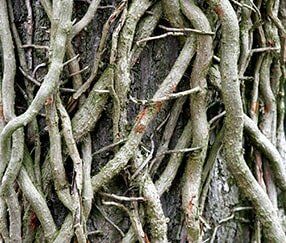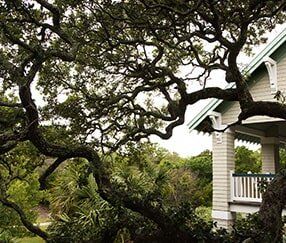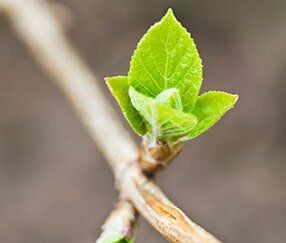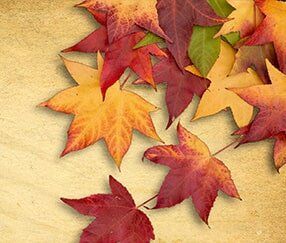Tree Care Advice from Jacksonville, IL
Tree Anatomy

Roots
The roots anchor the tree, provide water and nutrients and store carbohydrates The health of the roots depends on soil texture and depth. Disturbing the soil above and in the root system can cause death to the tree.

Branches
Branches give the tree it's basic shape and provide the leaves with the best exposure to the sun. The loss of a major branches may cause death to the tree.

Buds
Much of the tree's energy goes into producing buds that contain embryonic shoots, leaves and flowers for the next growing season.

Leaves
Leaves produce food for the tree. Pores on the leaves, known as stomata, take in carbon dioxide and release water and oxygen. When there is a lack of water they close and open when water is abundant.
Keeping Trees Healthy & Stress Free
A good start is to make sure you plant your new trees properly making them less vulnerable to stress. Research the species of tree you are planting and try to give it adequate shade and sun. Also make sure the tree will have room to grow. After planting place mulch around the base of the tree rather than grass or flowers.
Remembering the roots is a big part of your tree's health. When someone cuts parts of the roots some of the tree's crown will die.
Having good soil can mean the difference between a healthy and unhealthy tree. A frequent problem is compacted soil from traffic or adding too much soil around the tree. Remember not to place any soil around the tree trunk as this promotes disease and rot.
Improper watering of trees is a common mistake. No rain for 4-5 days can put serious stress on a tree. Make sure to give your trees water during droughts especially on newly planted trees. For mature trees, leave a hose trickling at the base of the tree overnight to saturate the root zone. Young trees require only an hour or two. Regular watering will enhance the healing of wounds and support the growth of new twigs, roots, shoots and callus tissue.
Pruning regularly promotes a healthy tree. This allows healthy branches to get more airflow and have to bear less weight of dead/decaying branches. Removing these branches also helps to prevent disease and rot.
Keeping Trees Healthy & Stress Free
Before watering any plant, always check the moisture content first. Plants may look wilted from too much water as well as from to little water.
Checking Soil Moisture
- Pull Back the mulch and dig down 1-4".
- You should water most plants when the soil is just moist.
- Moist soil will feel cool to the touch but not wet, and should be crumbly, but not dry and powdery.
- Deep watering is more effective than frequent, light watering as it encourages deep roots and drought tolerance.
- You should check plants more often in situations of high winds and high temperatures.
Conserving Moisture
- Mulch plants 2-3" deep with shredded hardwood, cypress, or cocoa hull mulch.
- Water slowly to avoid runoff. Soaker hoses are excellent for this.
- Do not use a sprinkler.
- It is better to sacrifice watering your lawn before your shrubs, trees, flowers and vegetables. The lawn will go dormant an is more likely to recover.
- Weed control is essential. Weeds will rob the soil of needed moisture.
When and How to Water
Shrubs
- Thoroughly water each plant with a slow, steady stream of water for approximately 3-5 minutes.
- When first planted, water once every 1 to 3 days for a couple of weeks.
- The next couple weeks, water once every 3-4 days.
- Water only once a week for a couple months until the plants become established.
- Typically, once a plant goes through an entire growing year, it will become established and only needs to be watered during very dry periods.
Shade and Ornamental Trees
- Thoroughly water each plant with a slow, steady stream of water and the base of the tree.
- For 1-3" diameter trunk, allow water to run for 1-2 hours or until water is no longer absorbed.
- Water at least once every 7 days.
- During dormancy and cool spring and fall months, watering may only be needed every 14-30 days.
- During high heat and wind, watering may be needed every 3-4 days.
Annuals, Perennials, and Groundcover
- Because of the size of these plants and the root stem being smaller, watering will need to be more frequent.
- Checking soil moisture levels daily during hot weather is critical.
- Good mulching practices and root stimulator will greatly enhance plant development.
Keeping Trees Healthy & Stress Free
More Frequently
Soil is very light and well drained
Weather is hot, sunny, or windy
Plants are small or newly planted
Plants are flowering
Plants are actively growing in spring or early summer
The area is exposed to wind and sun, west or south exposure
Less Frequently
Soil is clay or poorly drained
Weather is cool or humid
Plants are large and well established
Plants are going dormant
Area is sheltered or shaded
Plants are drought tolerant
Month-to-Month Gardening Guide
This section will help you with all of your gardening needs throughout the year.
January
Many of us think of spring as the beginning of the gardening year, but the truth is, the first seeds of a garden - the very idea of the garden and all of the planning that goes with it - are planted in winter.
Whether you're creating your first garden or refining your established garden, planning is an essential step in the process. In temperature climate areas, January is ideal for reviewing notes from last season; taking stock of seed supplies; mapping the location of new beds and borders; reading up on plant choices; and choosing new cultivars for your garden.
February
If February freezes make you shiver when you step outside, don't despair. Put your gardening enthusiasm to work indoors. There's much to do! February is prime time for starting seeds inside. In most areas, you can start seeds of cool-loving plants like broccoli, cabbage, onions, and pansies this month so the seedlings will be ready to plant outdoors in three to four weeks before the last frost. Near the end of the month, gardeners in many regions also can start warm-weather crops, such as tomatoes and peppers, and annual and perennial flowers.
Outdoors this month, focus on the framework of your landscape. Now is your chance to view "the bones" of your property with a critical eye to determine what changes you'll make this year. Consider what trees and shrubs to add or remove; where to put a new perennial bed or arbor; and which branches to prune before buds break and new growth begins.
Now's also the best time to get in touch with our office to order specific plant varieties you want to plant later this spring. Our qualified associates can help any questions or concerns you may have about your landscape and develop creative solutions to problem areas in the yard.
March
Could it be?...... A sign of warmth! Can winter finally be coming to an end?!
Do not fall so easily for that week of warm temps so typical this time of year. Almost assuredly, there will be a couple more freezes before winter finally gives up.
Take those days of warm to evaluate your yard, note trouble spots, start putting your plans from the winter onto your physical landscape and make changes where necessary.
If you absolutely can't stand to let a good day go to waste, go ahead and clean off plant debris and trim plants. BUT (and this is a big but) make sure you finish with a healthy layer of mulch. This is to prepare for any late winter freezes.
March is also the ideal time to incorporate organic material and other soil amendments into the soil of flower and food crop beds. A good compost will be well aged and have a balance of green and brown components. (Forgot to compost your leaves last fall? No worries! We've got you covered with ready-made compost at our office.)
April
Who needs a calendar to know it's spring? With magnolias, forsythia, daffodils, and fruit trees in full bloom, nature makes it abundandly clear that spring has arrived and, with it, planting time!
With plans made and beds prepared, you can start planting. Take advantage of increased daylight hours by setting out transplants in the evening. With a good soaking, the plants will settle in during the cool nighttime hours before the bright sun returns. Keep the plants semi-shaded for atleast the first several days, until they adjust. This is also the time to stock up on mulch.
Don't be surprised if you find yourself with a flat of bargain bedding plants or a discounted rose that isn't part of your plan! Until you figure out where to put your adoptees, stick them in a "nursery" bed to keep them from becoming more pot bound.
May
Some plants are so universally loved that it's hard to imagine a garden without them. Take tomatoes, for instance. Nearly everyone's favorite garden vegetable, tomatoes are one of the last things you give up when you can't grow much else. Even the smallest gardens usually will include at least one potted cherry or slicing tomato plant.
June
Some time this month, insect pests will discover your garden. Your plants can tolerate some damage. Besides, beneficial insects like lady beetles and parasitic wasps should soon arrive to keep the pests in check. However, when flower, fruit, or veggie damage seems to be getting out of hand, you can control pests effectively with non chemical methods, such as hand picking, and using sticky traps. Our office also has a wide variety of chemical measures if that's your cup o' tea!
Also, remember that healthy plants are much less susceptible to insects. To keep your plants strong and healthy, fertilize them with compost. Applying just ½ to 1 inch of it to your beds will help to keep plants healthy. Test your soil every few years to find out whether you need to add an amendment and, if so, how much. Provide plenty of water. If your garden hasn't been getting at least an inch of rain each week, you'll need to water it to ensure that plants don't suffer from drought stress. Usually, taking these steps is all that's needed.
July
This month is the time to harvest some vegetables and enjoy what you have grown. There is much more to gardening than just the end result though. July is mostly about the simple act of taking care of your garden: watering, trimming dead blossoms, mulching, staking plants, tending your compost, pulling weeds, feeding plants, and checking for pests.
August
August nights usually begin to hint that the end of this year's season soon will be here for most regions. There are at least a couple of ways you can keep your garden growing. One way is to extend the season for this year's crops. Another is to propagate your cuttings from already established plants.
September
In most places, the garden puts on its grand finale this month. Vegetables and fruits are producing at their peak and late summer asters, roses, and chrysanthemums are in full color. Usually this month weeds come strong so be sure to be prepared to weed your garden/landscape.
When the garden winds down, gardeners do what they can to preserve its bounty through the winter. September is for stocking up from the seasons last blooms.
October
This month leaves change color and fall from trees, days grow short, and cold nights. Though this month is usually the very end for gardeners and a good time to clean your garden/landscape one last time before winter.
November
Spend a few weekends this month putting your garden to bed, you'll actually be making a big investment in next years garden. Right now your yard should have a wealthy load of compostables such as leaves, grass, clippings, and spent plants.
Removing spent plants and fallen fruit from the garden does much more than make your property look good, it goes a long way toward preventing disease and insect problems next year.
December
A garden is much more than a place you designate for growing plants. A closer look shows that your garden is home to a variety of life ranging from barely visible insects to larger animals like toads and rabbits. Observing wildlife in your garden can be entertaining and educational but can also be a problem.
You can learn to live with these critters by observing their behavior. Understanding the habits of these animals can help you manage them, usually a sturdy fence fares best.







